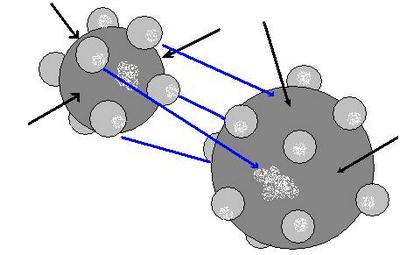A chemical bond is the interaction of atoms carried out by the exchange of electrons.
The reason for the formation of chemical bonds is the energy gain of a system of bound atoms compared to isolated atoms.
There are 4 types of chemical bonds – covalent, which in turn is divided into polar and non-polar, ionic, metallic and hydrogen.
The polarity of the bond depends on the electronegativity of the elements.
Covalent non-polar bond
It is formed between identical non-metals, that is, these elements have the same EO.
Consider the formation of a covalent non-polar bond, using the example of hydrogen:

covalent polar bond
It is formed between different non-metals, that is, there is a slight difference in EC between these elements.
Consider the formation of a covalent polar bond, using hydrogen sulfide as an example:

Ionic bond
It is formed between a metal and a non-metal, that is, there is a large difference in EO between substances. One of them donates its electrons and it becomes positively charged. An element that accepts electrons is negatively charged.

Metal bond – the socialization of valence electrons “electron gas” is carried out in simple substances – metals and their alloys (Na, Fe, Cr, Al, etc.).
A hydrogen bond is a bond between an electronegative atom (F, O, N) and a hydrogen atom that is covalently bonded to another electronegative atom (F, O, N).
Hydrogen bonds affect the physical (boiling point, melting point) and chemical (acid-base) properties of compounds.

Intermolecular hydrogen bonds cause the association of molecules, which leads to an increase in the boiling and melting points of the substance. For example, ethyl alcohol C2H5OH, capable of association, boils at +78.3°C, and dimethyl ether CH3OCH3, which does not form hydrogen bonds, only at –24°C (the molecular formula of both substances is C2H6O).
The chemical bond, its types, properties, along with chemical reactions, is one of the cornerstones of an interesting science called chemistry. In this article, we will analyze all aspects of chemical bonds, their significance in science, give examples and much more.
Definition
In chemistry, a chemical bond is understood as the mutual adhesion of atoms in a molecule and a crystal lattice, as a result of the action of an attractive force that exists between atoms. It is thanks to chemical bonds that various chemical compounds are formed, this is the nature of a chemical bond.
Relationship types
The mechanism of formation of a chemical bond strongly depends on its type or type; in general, the following main types of chemical bond differ:
- Covalent chemical bond (which in turn can be polar or non-polar)
- Ionic bond
- hydrogen bond
- Chemical bonding of metals
- similar people.
As for the covalent chemical bond, a separate article is devoted to it on our website, and you can read more details at the link. Further, we will analyze in more detail all the other main types of chemical bonds.
